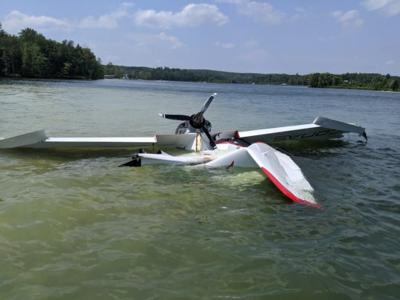Overweight, Out Of CG, and Pilot Error Were But A Few of The Many Issues In This Accident
Location: Lake, MI Accident Number: CEN19LA242
Date & Time: 07/27/2019, 1320 EDT Registration: N663BA
Aircraft: ICON A5 Aircraft Damage: Substantial
Defining Event: Unknown or undetermined Injuries: 1 Serious, 1 None
Flight Conducted Under: Part 91: General Aviation - Business

NTSB Analysis: The pilot was conducting a sales demonstration flight with a pilot-rated passenger on board. He reported that, when he started the takeoff run from a lake, three small wakes helped propel the airplane into the air. He stated that the airplane took off on the first attempt, the takeoff was normal, and "there was nothing wrong with the [air]plane at all." He added that, after initiating a 10° right turn to stay over the lake, it felt like the airplane "hit a wall." The airplane then descended rapidly, clipped a tree, and impacted water, which resulted in substantial damage to the fuselage and wings.
The pilot-rated passenger said that it took four takeoff attempts to get airborne and that the airplane felt very sluggish and acted as if it did not want to come off the water.
Postaccident weight and balance calculations revealed that the airplane was about 57 lbs over its maximum gross weight and outside of the weight and center of gravity limits contained in the pilot's operating handbook. Data retrieved from the airplane's onboard digital-to-analogue converter were consistent with three takeoff attempts, with the airplane becoming airborne on the third attempt. A review of video of the accident flight from witnesses showed the airplane in a nose-high attitude with the flaps extended as it approached trees during the initial climb. As the airplane reached about the midpoint of a stand of trees, the angle of attack appeared to increase and the nose dropped. The right wing then lowered and impacted one of the trees.
Probable Cause and Findings
The National Transportation Safety Board determines the probable cause(s) of this accident to be:
The pilot's improper decision to operate the airplane in exceedance of the airplane manufacturer's operating limitations, which led to an aerodynamic stall. Contributing to the accident was the pilot's improper decision to continue attempting the takeoff after two failed attempts.
Notes From ANN's E-I-C: The NTSB report is pretty damning... but when you go over all the notes and evidentiary data in a few dozen online files, you find other things to worry about. Why did the pilot state that the accident took place on the first take-off, when it plainly didn't? There were a number of unsuccessful take-off attempts -- which should have clued the pilot onto the fact that there were issues in flying that day. "The pilot-rated passenger said that it took four takeoff attempts to get airborne and that the airplane felt very sluggish and acted as if it did not want to come off the water."
The passenger stated the pilot said that there was adequate useful load when the findings show otherwise. The Icon A5 is a heavy bird and has little useful load to mess with, and the company pilot (with 120 hours in type) really should have been more attentive to that fact. Worse, still, is the witness report from a boater who reported that when he arrived on scene, right after the accident, that much of the Icon was underwater, and the passenger was still underwater. He said he had to pull the submerged PAX up and out of the water -- presumably to prevent drowning -- so this accident, absent some help from nearby boaters and others, could have been far more tragic. The company needs to take a strong look at its operational procedures, the minimal useful load offered by the aircraft, the anemic performance, and some of the crash survivability issues that appear to be highly problematic with the number and type of sinkings this bird has been involved in. This report, and others,
also continue to give me great cause to be concerned about other issues with the company and the airplane... but since it (the company) plainly fears a critical, comprehensive flight review and will not allow one from yours truly, we strongly recommend caution in flying this aircraft or doing business with this company.
 Bolen Gives Congress a Rare Thumbs-Up
Bolen Gives Congress a Rare Thumbs-Up The SportPlane Resource Guide RETURNS!!!!
The SportPlane Resource Guide RETURNS!!!! Buying Sprees Continue: Textron eAviation Takes On Amazilia Aerospace
Buying Sprees Continue: Textron eAviation Takes On Amazilia Aerospace Hawker 4000 Bizjets Gain Nav System, Data Link STC
Hawker 4000 Bizjets Gain Nav System, Data Link STC Echodyne Gets BVLOS Waiver for AiRanger Aircraft
Echodyne Gets BVLOS Waiver for AiRanger Aircraft


